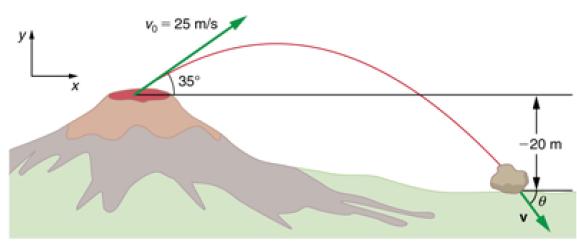Kilauea in Hawaii is the world's most continuously active volcano. Very active volcanoes characteristically eject red- hot
Question:
Kilauea in Hawaii is the world's most continuously active volcano. Very active volcanoes characteristically eject red- hot rocks and lava rather than smoke and ash. Suppose a large rock is ejected from the volcano with a speed of 25.0 m/s and at an angle 35.0° above the horizontal, as shown in Figure 3.37. The rock strikes the side of the volcano at an altitude 20.0 m lower than its starting point.
(a) Calculate the time it takes the rock to follow this path.
(b) What are the magnitude and direction of the rock's velocity at impact?

Strategy
Again, resolving this two-dimensional motion into two independent one-dimensional motions will allow us to solve for the desired quantities. The time a projectile is in the air is governed by its vertical motion alone. We will solve for t first. While the rock is rising and falling vertically, the horizontal motion continues at a constant velocity. This example asks for the final velocity. Thus, the vertical and horizontal results will be recombined to obtain v and θv, at the final time t determined in the first part of the example.
Step by Step Answer:






